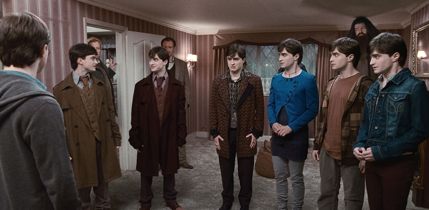Harry Potter movies are hard to review. For fans of the books (as I am) it’s often hard to disassociate the movies from the original text and see the necessary changes—most frequently for length—with any kind of objectivity. For reviewers who haven’t read the books, the shorthand screenwriter Steve Kloves (who adapted all but Order of the Phoenix, for which Michael Goldenberg took over) employs often leads to the movies seeming incomprehensible. Characters who appear in one or two scenes (like wisecracking twins Fred and George Weasley, for instance) are treated with a significance that may seem confusing to a viewer unfamiliar with the Potterverse. This is but one of many problems one has adapting a book of 700+ pages into a two and a half hour movie.
Warning, spoilers below.
For Harry Potter and the Deathly Hallows, the final book of seven, the series’ producers decided to split the narrative into two movies. This lead to a great deal of cynicism regarding their motives (widely and probably accurately attributed to a desire to increase profits) and also to the main problem with Part 1 as a movie: it’s an incomplete story. The movie follows the book’s plot with only cosmetic changes: following the death of the great Dumbledore at the hands of the (apparently) treacherous double-agent Severus Snape, Harry and his best friends Ron and Hermione are tasked with hunting down and destroying a number of horcruxes, which are magical repositories into which principal antagonist Voldemort has concealed pieces of his soul in order to ensure his immortality. Only when all the horcruxes are destroyed can Voldemort be truly killed, and Harry is the one who has to do it.
The movie assumes that the viewer already knows this, as all of the above-mentioned principals are established with maximum economy and minimum extraneous explanation (or, really, any explanation other than “Hey, there’s Hermione, there goes Ron, that’s Harry, Voldemort just killed someone while Snape looks on inscrutably and GO!”) In spite of the producers’ claim that Deathly Hallows was done as two separate movies in order to preserve as much of the story as possible, we miss out on the truly touching farewell between Harry and Dudley Dursley in the beginning, as well as many other scenes. But it’s a bit too late to complain about changes made in the adaptation. This is something fans of the books have had to deal with for the entire series, and it will not change in the final movie, even if the final book is being told over two movies.
While screenwriter Kloves is always going to be the bad guy to fans angry about elements and scenes being cut or rushed unnecessarily, director David Yates (who also directed Order of the Phoenix and Half-Blood Prince) does some of his best work yet in the series. Yates employs cinematic language very skillfully to elaborate on gaps in the script, with some occasional original touches: the opening extreme close-up on Minister of Magic Rufus Scrimgeour’s (Bill Nighy’s) eyes as he delivers a very War on Terror-esque speech comes to mind. As Scrimgeour speaks to the assembled press and Ministry, the choice of perspective establishes very clearly, and in terms both fans and non-fans alike can understand, that this movie is about a battle to the end against a very dangerous foe. Yates’s pre-Potter work, like the British miniseries State of Play, was often highly political, and he can’t resist the temptation to draw parallels with contemporary geopolitics. These don’t interfere overmuch with the story beyond a brief aside, as the focus remains squarely on Harry and the expensive visual effects.
The fancy visuals go a long way toward cloaking the fact that this is only half the movie. Yates loads this first installment with action set-pieces, the most impressive (and first) being Harry’s escape from the Dursley home. This escape is aided by several magically-disguised clones; watching seven different Harrys walking around and still maintaining the physicality and voices of the other actors is a nifty bit of acting on star Daniel Radcliffe’s part and a lovely visual joke. Many of the others are a bit too protracted, with entirely too much inky black flying Death Eater smoke (an effect I’ve never particularly liked).
With so much feeling like padding in this the first part of two, one is forced to wonder whether it was truly necessary to split Deathly Hallows into two movies. In two and a half hours, we have only found and destroyed one horcrux, and the climactic death (a diminutive, high-voiced supporting character), a greatly affecting mid-point for the narrative of the book, does not make for much of an ending.
Harry Potter and the Deathly Hallows, Part 1 is a well-crafted movie, and displays the leaps and bounds Dan Radcliffe, Emma Watson, and Rupert Grint have made as actors. But it is not essential viewing just this instant. It will probably do one better to watch both as a single movie upon the release of Part 2 in July of next year. Until then, when the whole can be evaluated, it would be difficult to say whether it really works as a movie or not. For now Part 1 is incomplete, maybe the longest and most expensive trailer ever made, to prepare audiences for the main event next year.
Danny Bowes is a playwright, filmmaker and blogger. He is also a contributor to nytheatre.com and Premiere.com.










